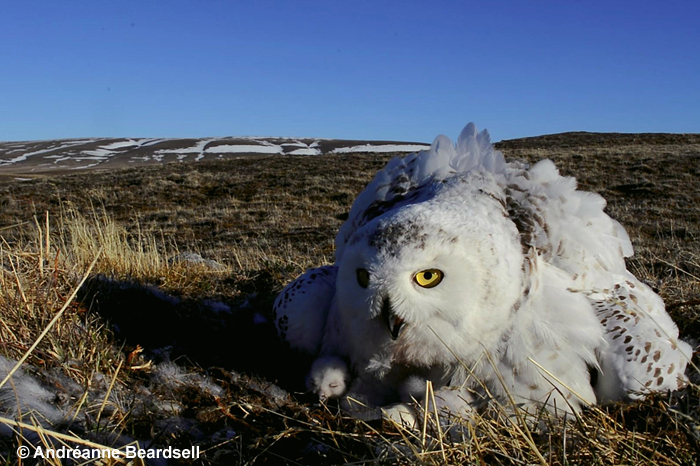 |
The snowy owl is one of the predators that can be found periodically on Bylot Island. This large northern owl breeds in the open tundra across the circumpolar Arctic. Even though snowy owls can withstand the long and harsh Arctic winter, it was previously believed that they winter in more southerly areas such as southern Canada, northern United States and central Eurasia, where they can find prairies, marshes and open fields to feed on small mammals present in those areas. However, our research shows that owls breeding in the eastern Canadian Arctic can and do remain in the Arctic throughout the winter by relying on the marine and coastal environments to find their food. Between 2007 and 2016, we captured several adult female snowy owls on Bylot Island and Mary River (Nunavut) and Deception Bay (northern Quebec) and equipped them with satellite transmitters to track their migratory movements in real time for up to 3 years. This study revealed that most females spent several weeks (up to 101 days) on or near sea ice from December to April. Most satellite locations were close to open patches of water (called polynyas) where eider ducks often gather during the winter. Since polynyas are recurrent winter sites for sea ducks it provides potentially predictable winter prey for owls at higher latitudes allowing them to have shorter migration to their breeding ground compared to birds choosing to winter in temperate regions. Most snowy owls also showed fidelity to their wintering environment (marine vs. inland) and latitudinal zone (Arctic vs. temperate) from one year to the next as their average dispersal between two consecutive winters was 389 km (range: 20 to 2,731 km) which is shorter than their breeding dispersal (see Breeding ecology below). Although ‘winter irruptions’ of snowy owls in temperate North America (southern Canada and northern USA) are mostly comprised of young of the year and immature birds following a good reproduction year up north, adults also migrate to those areas and some even switch their wintering latitudinal zones between consecutive winters.
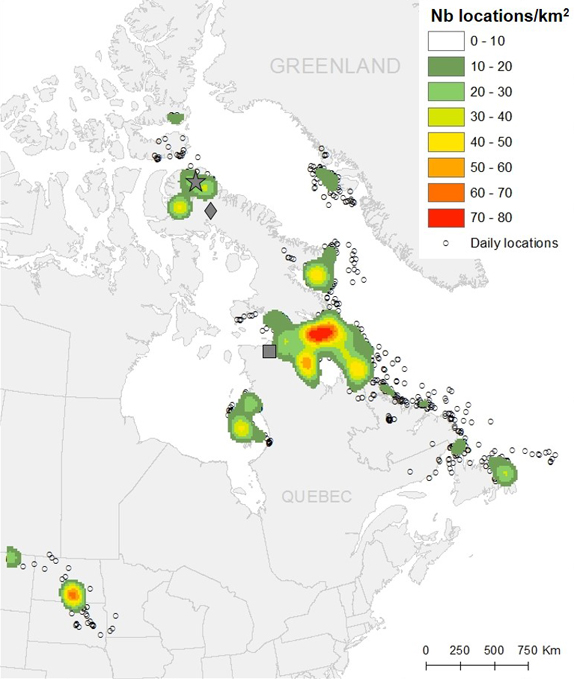 |
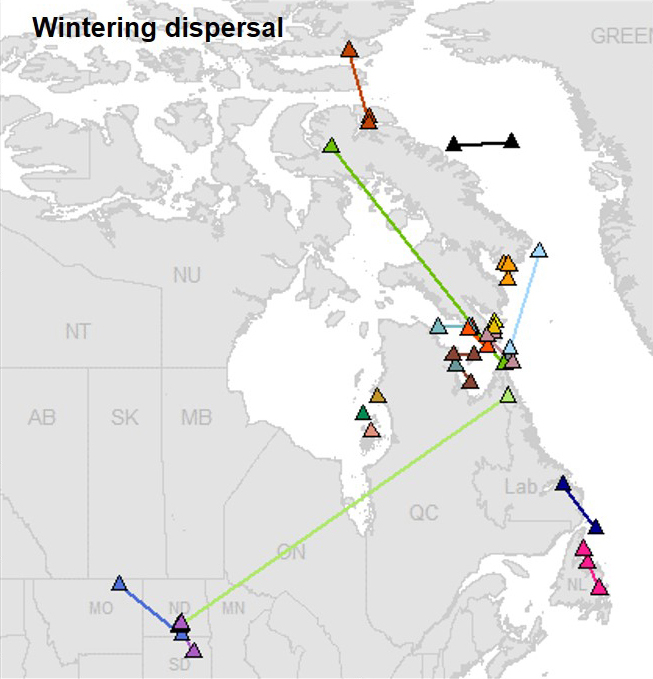 |
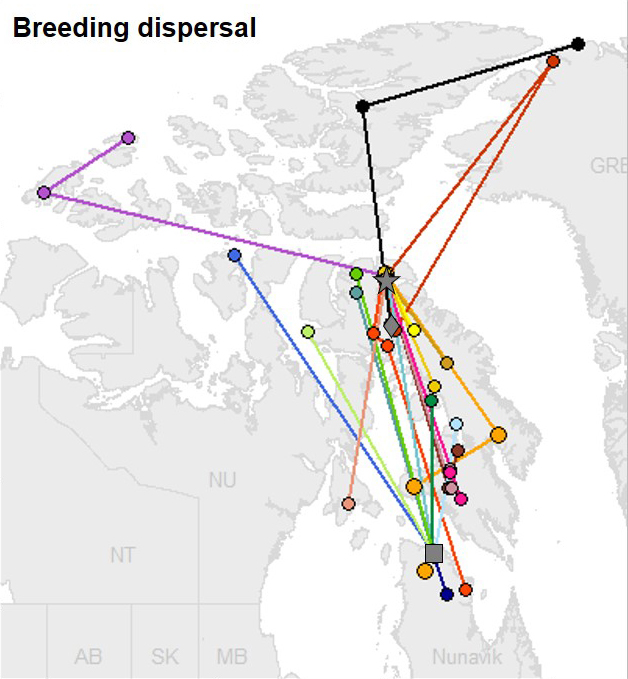 |
||
| Winter hot spots of adult snowy owls. Capture sites are Bylot Island (star), Mary River (diamond) and Deception Bay (square). From Robillard et al. 2018, DOI 10.1111/jav.01707. | Wintering dispersal of adult snowy owls. Each color represents a different individual. From Robillard et al. 2018, DOI 10.1111/jav.01707. | Breeding dispersal of adult snowy owls. Capture sites are Bylot Island (star), Mary River (diamond) and Deception Bay (square). Each color represents a different individual. From Robillard et al. 2018, DOI 10.1111/jav.01707. |
Breeding ecology
Although known as a partial migrant species, the nomadic and irruptive migratory movements of snowy owl are related to fluctuations in the abundance of its main prey, lemmings, during the breeding season. On Bylot Island, collared and brown lemmings consist of about 96% of its diet with some snow goose goslings and to a lesser extent longspurs, shorebirds, ermines and fox cubs. Hence, snowy owls do not show fidelity to a particular breeding site as their decision to breed is entirely based on the abundance of lemmings needed to feed their young. Females that were tracked via satellite transmitters were shown to breed on average 710 km (range: 85 to 1,617 km) away from their breeding site of the previous year.
We have been monitoring the nesting activities of snowy owls on Bylot Island since 1993 and they are usually seen during summers of high lemming abundance. During those summers, up to 98 nests have been found within our study area but only those located in the Qarlikturvik Valley are monitored more closely. During years of very low lemming abundance, owls are not present on the island or a few individuals are seen very early in spring and then leave the area to breed in regions where the abundance of lemmings is higher.
Their nest is generally located on a ridge, a small mound on a gentle slope or along a ravine or a deep gully in mesic tundra. These areas are usually the first to get free of snow in spring which allows snowy owls to start breeding fairly early in the season. The average laying date (date when the first egg is laid) of owls on Bylot Island is 21 May (range: 13 to 29 May). Females lay between 3 and 11 eggs (average: 7 eggs/nest) in a shallow depression scraped out directly on the ground. Since females lay their eggs at intervals of about 2 days and start to incubate immediately after the first one is laid, eggs do not hatch at the same time. The average hatching date (date when the first egg hatches) is 21 June (range: 14 to 30 June). Young owls gradually leave the nest starting with the oldest one around 2 to 3 weeks of age.
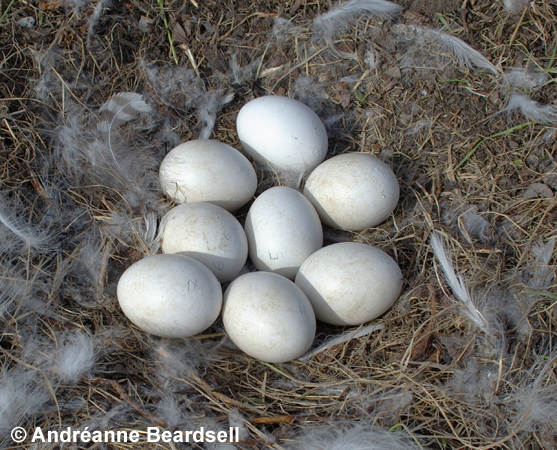 |
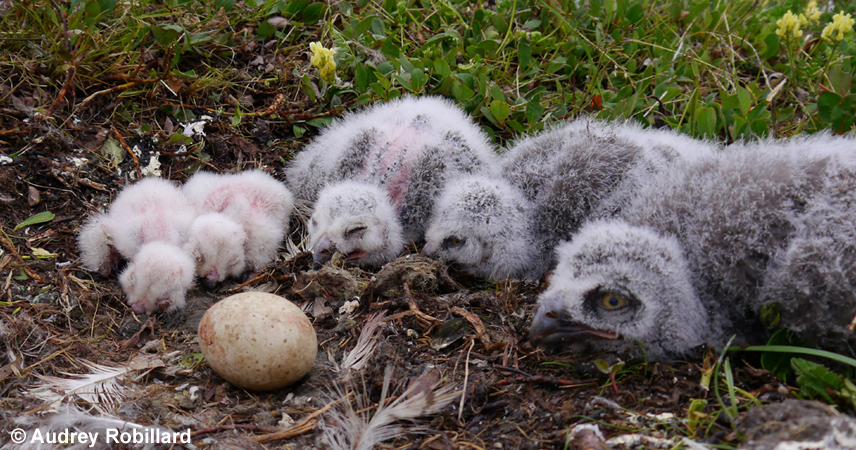 |
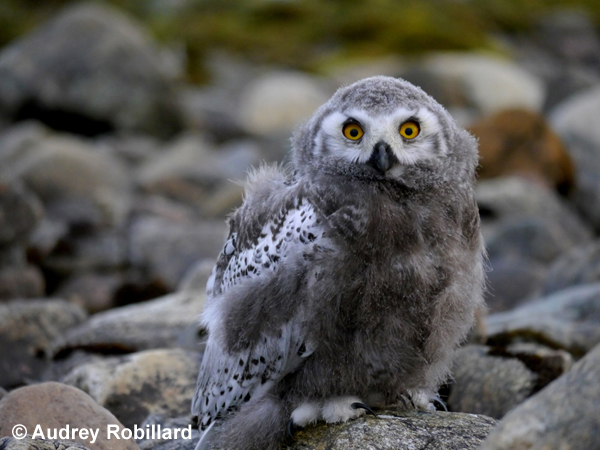 |
Although breeding parameters such as laying date and clutch size (total number of eggs layed) vary among years, our analyses show that they are not influenced by the onset of spring (i.e. snow melt) or the abundance of lemmings. It seems that when and where an owl pair decides to nest, their nesting success is usually quite high. The fact that lemming abundance was relatively high in some years, but that no owls were found nesting on the island (ex. 2011 and 2015) suggests that during the pre-breeding period (March to May), when owls are prospecting the tundra for a potential nesting site they might settle for the first one that shows a high lemming abundance. During those years, the lemming abundance seen on Bylot Island might be comparable across a larger area allowing owls to start nesting earlier at lower latitudes and save energy for breeding instead of travelling to an area further north with a similar prey abundance.
The full dataset of our snowy owl nesting monitoring on Bylot Island is available on Nordicana D.
| Lemmings | Long-tailed jaeger |
